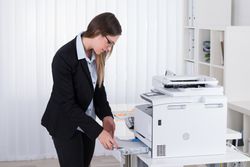
Most businesses rely on printers and copiers to produce documents, but the quality of the paper used to print these documents often goes overlooked. Not all paper is made equal, and using the wrong kind can be detrimental to your machine over time. Instead of calling a printer service expert for help with a faulty printout, the best solution might be to change the paper you use. Here’s a closer look at how to find the best paper quality for your needs.
Factors That Affect Paper Quality
There are numerous types of paper to choose from, and each has different characteristics. Depending on its properties, a glossy, white paper may be perfect for printing photos, but it could perform poorly in producing documents — or the opposite could hold true.
Brightness
Paper types are identified by their brightness, which refers to how light reflects on a sheet. This characteristic is measured using a scale from 0 to 100. The higher the number, the sharper the images or text will be on a page. Most copier paper falls somewhere around 90, although pricier varieties often have a brightness closer to 100. If you plan to produce documents with vibrant, vivid colors, opt for brighter papers.
Shade
In addition to brightness, papers are defined by their shade or tone. Differences in tone produce varying shades—just as with paint colors. For instance, a creamy white shade creates a softer image than a brighter sheet. Shade is vital for photographers and artists, who need to achieve accurate colors and tones.
Weight
The weight of paper is measured in grams per square meter, or GSM. This trait refers to the paper’s heft and thickness. It affects how a print looks on paper. Standard copy papers come in 20 GSM — thick enough to produce printouts without bleeding and thin enough to prevent paper jams. Heavy papers — with 28 to 32 GSM — are referred to as card stock, since they are typically used for business cards and similar applications.
Why the Right Paper Type Matters
When choosing  paper for your printing machine, you have to understand how inkjets and laser printers work. Inkjets spray ink onto the paper while laser printers melt toner onto a sheet using high heat. Most copy papers work on both printer types; however, they’re more likely to smear with inkjets, particularly paper varieties with lower GSM. A printer service expert can recommend the optimal paper varieties for your printers.
paper for your printing machine, you have to understand how inkjets and laser printers work. Inkjets spray ink onto the paper while laser printers melt toner onto a sheet using high heat. Most copy papers work on both printer types; however, they’re more likely to smear with inkjets, particularly paper varieties with lower GSM. A printer service expert can recommend the optimal paper varieties for your printers.
If you are planning to print images, inkjets do a better job, as long as you use the right paper type. Most printer service providers suggest that you use uncoated inkjet papers, since they have higher brightness and use more fiber for efficient ink absorption, which minimizes bleeding. On the other hand, laser-friendly papers have minimal coatings but are heat-resistant, even at low GSM. If you’re having difficulty achieving your desired print results, contact a print service provider to see if the issue is due to your printer or your paper.
When you need advice on the right paper for the job, trust the professionals at Laser Line in Jessup, MD. They’re the experts on copier machines, carrying an impressive selection of quality products and printing supplies. They also offer printer installation and managed print services across northern Virginia, Maryland, and Washington, D.C. Call (410) 636-1700 or request printer service online.
About the Business
Have a question? Ask the experts!
Send your question

